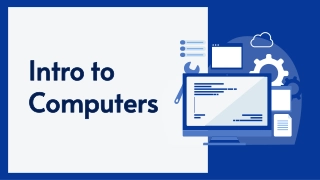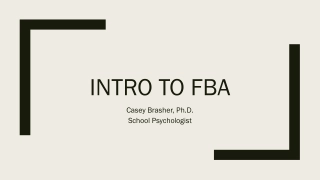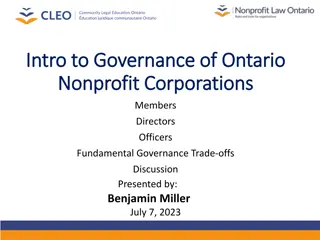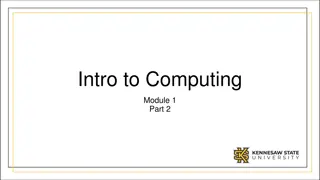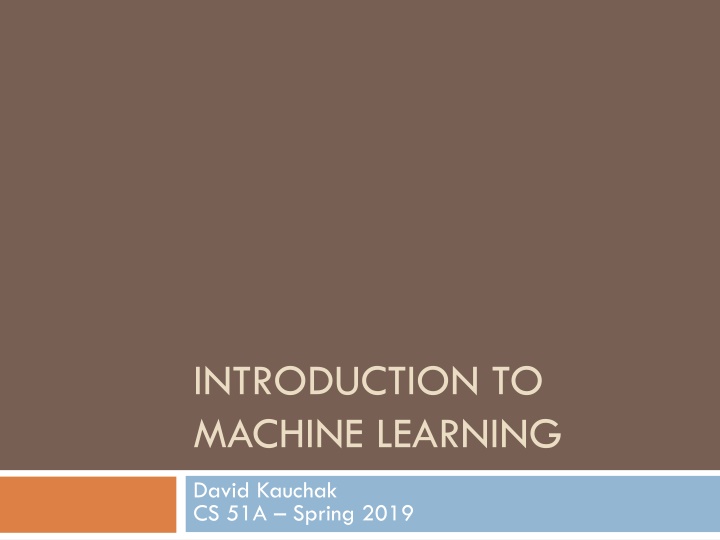
Introduction to Machine Learning and Its Applications
Explore the concept of machine learning, which involves predicting the future based on past data. This course delves into supervised learning, classification, and various applications such as face recognition, character recognition, spam detection, and medical diagnosis. Understand the fundamentals of training data, testing data, and models in machine learning.
Download Presentation

Please find below an Image/Link to download the presentation.
The content on the website is provided AS IS for your information and personal use only. It may not be sold, licensed, or shared on other websites without obtaining consent from the author. If you encounter any issues during the download, it is possible that the publisher has removed the file from their server.
You are allowed to download the files provided on this website for personal or commercial use, subject to the condition that they are used lawfully. All files are the property of their respective owners.
The content on the website is provided AS IS for your information and personal use only. It may not be sold, licensed, or shared on other websites without obtaining consent from the author.
E N D
Presentation Transcript
INTRODUCTION TO MACHINE LEARNING David Kauchak CS 51A Spring 2019
Machine Learning is Machine learning is about predicting the future based on the past. -- Hal Daume III
Machine Learning is Machine learning is about predicting the future based on the past. -- Hal Daume III past future Training Data Testing Data model/ predictor model/ predictor
Data examples Data
Data examples Data
Data examples Data
Data examples Data
Supervised learning examples label label1 label3 labeled examples label4 label5 Supervised learning: given labeled examples
Supervised learning label label1 model/ predictor label3 label4 label5 Supervised learning: given labeled examples
Supervised learning model/ predictor predicted label Supervised learning: learn to predict new example
Supervised learning: classification label apple Classification: a finite set of labels apple banana banana Supervised learning: given labeled examples
Classification Applications Face recognition Character recognition Spam detection Medical diagnosis: From symptoms to illnesses Biometrics: Recognition/authentication using physical and/or behavioral characteristics: Face, iris, signature, etc ...
Supervised learning: regression label -4.5 Regression: label is real-valued 10.1 3.2 4.3 Supervised learning: given labeled examples
Regression Example Price of a used car x : car attributes (e.g. mileage) y : price 15
Regression Applications Economics/Finance: predict the value of a stock Epidemiology Car/plane navigation: angle of the steering wheel, acceleration, Temporal trends: weather over time
Supervised learning: ranking label 1 Ranking: label is a ranking 4 2 3 Supervised learning: given labeled examples
Ranking example Given a query and a set of web pages, rank them according to relevance
Ranking Applications User preference, e.g. Netflix My List -- movie queue ranking iTunes flight search (search in general) reranking N-best output lists
Unsupervised learning Unupervised learning: given data, i.e. examples, but no labels
Unsupervised learning applications learn clusters/groups without any label customer segmentation (i.e. grouping) image compression bioinformatics: learn motifs
Reinforcement learning left, right, straight, left, left, left, straight GOOD BAD left, straight, straight, left, right, straight, straight left, right, straight, left, left, left, straight 18.5 -3 left, straight, straight, left, right, straight, straight Given a sequence of examples/states and a reward after completing that sequence, learn to predict the action to take in for an individual example/state
Reinforcement learning example Backgammon WIN! LOSE! Given sequences of moves and whether or not the player won at the end, learn to make good moves
Other learning variations What data is available: Supervised, unsupervised, reinforcement learning semi-supervised, active learning, How are we getting the data: online vs. offline learning Type of model: generative vs. discriminative parametric vs. non-parametric
Representing examples examples What is an example? How is it represented?
Features examples features How our algorithms actually view the data f1, f2, f3, , fn f1, f2, f3, , fn Features are the questions we can ask about the examples f1, f2, f3, , fn f1, f2, f3, , fn
Features examples features How our algorithms actually view the data red, round, leaf, 3oz, green, round, no leaf, 4oz, Features are the questions we can ask about the examples yellow, curved, no leaf, 8oz, green, curved, no leaf, 7oz,
Classification revisited label examples red, round, leaf, 3oz, apple green, round, no leaf, 4oz, apple model/ classifier yellow, curved, no leaf, 8oz, banana banana green, curved, no leaf, 7oz, During learning/training/induction, learn a model of what distinguishes apples and bananas based on the features
Classification revisited Apple or banana? model/ classifier red, round, no leaf, 4oz, The model can then classify a new example based on the features
Classification revisited model/ classifier Apple red, round, no leaf, 4oz, Why? The model can then classify a new example based on the features
Classification revisited Training data Test set label examples red, round, leaf, 3oz, apple red, round, no leaf, 4oz, ? green, round, no leaf, 4oz, apple yellow, curved, no leaf, 4oz, banana banana green, curved, no leaf, 5oz,
Classification revisited Training data Test set label examples red, round, leaf, 3oz, apple red, round, no leaf, 4oz, ? green, round, no leaf, 4oz, apple yellow, curved, no leaf, 4oz, banana Learning is about generalizing from the training data banana green, curved, no leaf, 5oz,
A simple machine learning example http://www.mindreaderpro.appspot.com/
models model/ classifier We have many, many different options for the model They have different characteristics and perform differently (accuracy, speed, etc.)
Probabilistic modeling probabilistic model: training data Model the data with a probabilistic model which tells us how likely a given data example is p(example)
Probabilistic models Example to label probabilistic model: apple or banana yellow, curved, no leaf, 6oz p(example) features
Probabilistic models For each label, ask for the probability probabilistic model: yellow, curved, no leaf, 6oz, banana yellow, curved, no leaf, 6oz, apple p(example) label features
Probabilistic models Pick the label with the highest probability probabilistic model: 0.004 yellow, curved, no leaf, 6oz, banana 0.00002 yellow, curved, no leaf, 6oz, apple p(example) label features
Probability basics A probability distribution gives the probabilities of all possible values of an event For example, say we flip a coin three times. We can define the probability of the number of time the coin came up heads. P(num heads) P(3) = ? P(2) = ? P(1) = ? P(0) = ?
Probability distributions What are the possible outcomes of three flips (hint, there are eight of them)? T T T T T H T H T T H H H T T H T H H H T H H H
Probability distributions Assuming the coin is fair, what are our probabilities? number of times it happens probability = total number of cases T T T T T H T H T T H H H T T H T H H H T H H H P(num heads) P(3) = ? P(2) = ? P(1) = ? P(0) = ?
Probability distributions Assuming the coin is fair, what are our probabilities? number of times it happens probability = total number of cases T T T T T H T H T T H H H T T H T H H H T H H H P(num heads) P(3) = ? P(2) = ? P(1) = ? P(0) = ?
Probability distributions Assuming the coin is fair, what are our probabilities? number of times it happens probability = total number of cases T T T T T H T H T T H H H T T H T H H H T H H H P(num heads) P(3) = 1/8 P(2) = ? P(1) = ? P(0) = ?
Probability distributions Assuming the coin is fair, what are our probabilities? number of times it happens probability = total number of cases T T T T T H T H T T H H H T T H T H H H T H H H P(num heads) P(3) = 1/8 P(2) = ? P(1) = ? P(0) = ?
Probability distributions Assuming the coin is fair, what are our probabilities? number of times it happens probability = total number of cases T T T T T H T H T T H H H T T H T H H H T H H H P(num heads) P(3) = 1/8 P(2) = 3/8 P(1) = ? P(0) = ?
Probability distributions Assuming the coin is fair, what are our probabilities? number of times it happens probability = total number of cases T T T T T H T H T T H H H T T H T H H H T H H H P(num heads) P(3) = 1/8 P(2) = 3/8 P(1) = 3/8 P(0) = 1/8
Probability distribution A probability distribution assigns probability values to all possible values Probabilities are between 0 and 1, inclusive The sum of all probabilities in a distribution must be 1 P(num heads) P(3) = 1/8 P(2) = 3/8 P(1) = 3/8 P(0) = 1/8
Probability distribution A probability distribution assigns probability values to all possible values Probabilities are between 0 and 1, inclusive The sum of all probabilities in a distribution must be 1 P P P(3) = -1 P(3) = 1/2 P(2) = 2 P(2) = 1/2 P(1) = 0 P(1) = 1/2 P(0) = 0 P(0) = 1/2
Some example probability distributions probability of heads (distribution options: heads, tails) probability of passing class (distribution options: pass, fail) probability of rain today (distribution options: rain or no rain) probability of getting an A (distribution options: A, B, C, D, F)
Conditional probability distributions Sometimes we may know extra information about the world that may change our probability distribution P(X|Y) captures this (read probability of X givenY ) Given some information (Y) what does our probability distribution look like Note that this is still just a normal probability distribution


